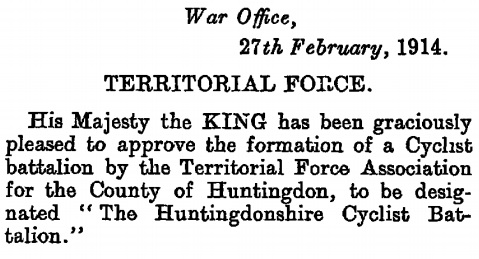The Army Cyclist Corps: the Huntingdonshire Battalion
The official Army Cyclist Corps (ACC) was formed in 1914, absorbing a number of pre-existing cyclist battalions from the Territorial Force. More cyclist units were raised during the war, but these all wore the ACC badge, whereas the pre-existing units wore their own distinctive unit badges. In August 1914, 15 cyclist battalions existed on mobilisation, one of which was the Huntingdonshire Cyclist Battalion (Gazette issue 28807).
A bicycle was an ideal means of transportation, as it was  comparatively lightweight – it could be carried over obstructions – and as well as
being ridden, could be loaded with equipment and pushed. It was particularly well-suited
to conveying despatches, guerrilla action, patrols and reconnaissance. A motorcycle
was faster, but a bicycle was silent. Cyclist units therefore played a big part in
the early stages of the war.
comparatively lightweight – it could be carried over obstructions – and as well as
being ridden, could be loaded with equipment and pushed. It was particularly well-suited
to conveying despatches, guerrilla action, patrols and reconnaissance. A motorcycle
was faster, but a bicycle was silent. Cyclist units therefore played a big part in
the early stages of the war.
Cyclists were initially excited by the prospect of exclusive cyclist battalions, enlisting with their friends and fellow riders. The first cyclist units went overseas to France and Flanders and to Gallipoli In 1915.
In the early days, military cyclists proved their worth, and there were numerous reports of their bravery in the British cycling press (Gazette supplement 31088). But trench warfare forced the reassignment of soldiers from cyclist units to infantry units, and though bicycles were still used extensively throughout the war by all sides, there was less need for actual cyclist units.
By the end of the war in France and Flanders, the cyclist battalions had been reformed and the count was still 15 English with a New Zealand, Australian and Canadian corps added, making 18 in total.
During World War 1 operations, cyclists often found themselves in unfriendly and difficult terrain and had to give up their mounts. Based on that experience, the British army found no long-term role for cyclists, and the Army Cyclist Corps was disbanded in 1919.
It is not possible to know exactly how many military cyclists there were during WW1, but it is estimated that at least 100,000 British soldiers used bicycles in some capacity, as did at least 150,000 French and Belgians.
In 1914, the British army had 14,000 men in cycle regiments and battalions, increasing to 20,000 by the end of the war. When the US entered the war in 1917, they shipped 26,407 bicycles with them to France, although they didn’t have any established bicycle corps.
The Huntingdonshire Cyclist Battalion
The formation of a Huntingdonshire Cyclist Battalion was approved by the War Office in February 1914 (Gazette issue 28807).
A number of NCOs and men from the two Huntingdonshire companies of the Bedfordshire Regiment were transferred to the new battalion. Eight companies were formed with headquarters in Godmanchester: two local and one in St Ives and Somersham, St Neots and Kimbolton, Ramsey and Warboys, Yaxley and Farcet and two in Fletton, Stanground and Peterborough. The Regimental Band was the original civilian Fletton Victoria Prize Band.
The battalion had its one and only annual territorial camp in Skegness in July 1914. On 4 August, within days of returning, war was declared (Gazette supplement 28861) and the battalion was mobilised and sent by train to Grimsby with 550 officers and men to patrol the coast between Scarborough and Grimsby. The battalion was moved to Scarborough in 1916, and to Whitby in June 1918.
A second battalion of cyclists was quickly formed and sent to Lincolnshire for coastal guard duties in October 1914.
In the spring of 1915, a third battalion was authorised but unable to reach full strength, so it was disbanded, with the men who had been recruited being shared between the other two battalions.
After two years of training and coastal patrols, the majority of the 1st Battalion were drafted to France on 28 July 1916 to serve in a reconnaissance role, and like all those who followed them, were rebadged to other regiments. The Huntingdonshire cyclists were never able to fight as a unit outside the UK and eventually men with no Huntingdonshire affiliations were drafted into the two battalions.
With the end of the War on 11 November 1918 (Armistice Day), the 1st Battalion was stood down on 14 April 1919, and the 2nd Battalion on 12 December 1919. A year later it was reconstituted as the 5th (Huntingdonshire Battalion) the Northamptonshire Regiment.
About the author
Peter Blakeman is newsletter editor and chair of the Cycling Campaign for North Bedfordshire (CCNB), which aims to encourage the consideration of the needs of cyclists in all aspects of transport planning and management and promote and encourage cycling as a means of transport and recreation.
The full version of this article can be read here. See also: A short history of cycling in Bedford
